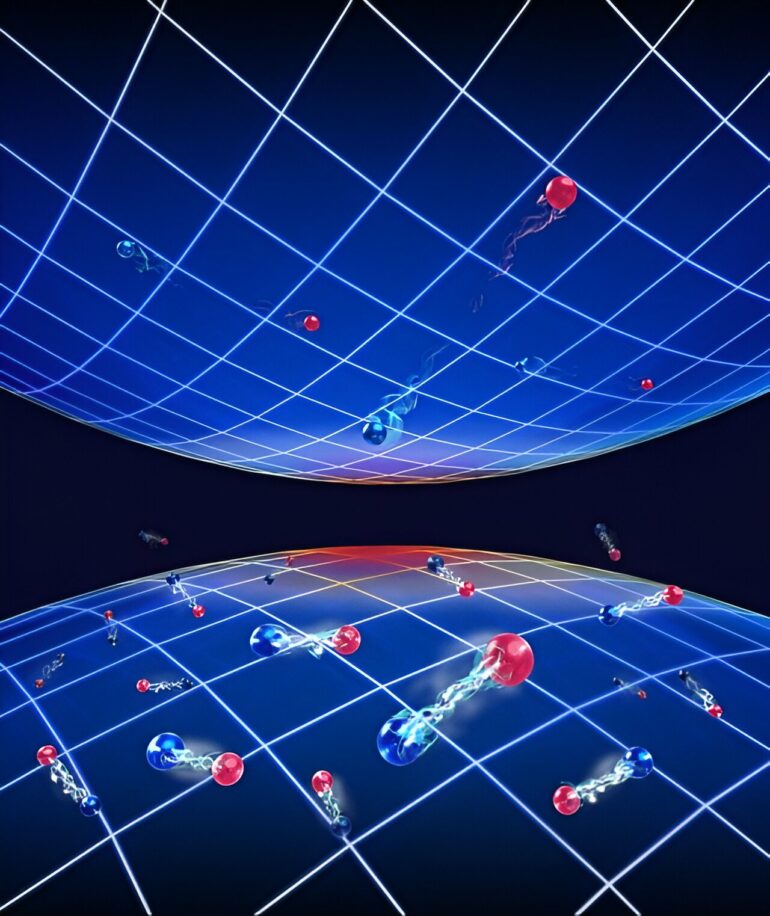A research team has, for the first time, observed and quantitatively characterized the many-body pairing pseudogap in unitary Fermi gases. This achievement, pursued by the ultracold atomic community for nearly two decades, resolves longstanding debates regarding the existence of a pairing pseudogap in these gases. It also supports pairing as a possible origin of the pseudogap in high-temperature superconductors, within the framework of preformed-pair superconductivity theory.
Published in Nature on Feb. 7, the study, led by Professors Pan Jianwei, Yao Xingcan, and Chen Yu’ao from the University of Science and Technology of China (USTC) of the Chinese Academy of Sciences, coincides with the upcoming Year of the Dragon. Interestingly, the physics behind this achievement can be vividly illustrated by the iconic Chinese myth of “Carp Jumping Over the Dragon Gate,” symbolizing great success in Chinese culture.
The existence of an energy gap is a hallmark phenomenon of superconductivity. In conventional superconductors, the energy gap exists below the superconducting transition temperature (Tc). In cuprate high-temperature superconductors, the energy gap can still be observed even above Tc, a phenomenon known as the pseudogap.
Understanding the origin and nature of the pseudogap is crucial for grasping the mechanism of high-temperature superconductivity, particularly regarding how Cooper pairs form and establish long-range phase coherence.
There are two main hypotheses for the pseudogap’s origin: It results from strong pair fluctuations, manifesting as preformed electron pairs above Tc and serving as a precursor to coherent pair condensation; and it arises from various quantum orders in high-temperature superconductors, such as the antiferromagnetic order, stripe phase, and pair density wave. Yet the complexity of high-temperature superconducting materials leaves these questions largely unanswered.

In this artistic representation, two carps, each clasping a jade bead in its mouth, symbolize fermions with opposite spins. The Dragon Gate represents both the superfluid transition and the pseudogap. The depiction of the carps leaping over the Dragon Gate suggests the pairing above the superfluid phase transition temperature. This pairing phenomenon, in turn, leads to the appearance of the pseudogap. © Chen Lei
Unitary Fermi gases provide an ideal quantum simulation platform for investigating the existence and characteristics of a pairing pseudogap. This may be attributed to their unprecedented controllability, purity, and, most importantly, the presence of known short-range attractive interactions. Additionally, the absence of a lattice structure in bulk Fermi gases eliminates the influence of competing quantum orders.
In this context, previous experiments have measured the trap-averaged single-particle spectral function of strongly interacting Fermi gases. However, these experiments have not provided convincing evidence of a pseudogap, primarily due to the inhomogeneity of the trap and serious issues arising from final-state interactions in the commonly used rf spectroscopy.
After years of dedicated work, the USTC research team has established a quantum simulation platform using ultracold lithium and dysprosium atoms, and has achieved a state-of-the-art preparation of homogeneous Fermi gases (Science). Additionally, this team developed novel techniques to stabilize the required magnetic fields.
At a magnetic field of approximately 700 G, the short-term fluctuations achieved are below 25 μG, resulting in a record-high relative magnetic field stability. This ultra-stable magnetic field enabled the research team to use microwave pulses to excite atoms to high-lying energy states that do not interact with the initial states, thereby realizing momentum-resolved photoemission spectroscopy.
With these two crucial technical breakthroughs, the research team systematically measured the single-particle spectral function of unitary Fermi gases at different temperatures and observed the existence of the pairing pseudogap, lending support for the role of preformed pairing as a precursor to superfluidity.
Furthermore, the research team determined the pairing gap, pair lifetime, and single-particle scattering rate from the measured spectral function, which are essential quantities for characterizing the behavior of strongly interacting quantum systems.
These findings not only advance the study of strongly correlated systems, but also provide valuable insights and information for establishing a proper many-body theory.
The techniques developed in this work lay the foundation for future exploration and study of other important low-temperature quantum phases, such as single-band superfluidity, stripe phases, and Fulde–Ferrell–Larkin–Ovchinnikov superfluidity.
More information:
Jian-Wei Pan, Observation and quantification of the pseudogap in unitary Fermi gases, Nature (2024). DOI: 10.1038/s41586-023-06964-y. www.nature.com/articles/s41586-023-06964-y
Provided by
Chinese Academy of Sciences
Citation:
Quantum simulation with ultracold fermions unveils pairing pseudogap (2024, February 7)



